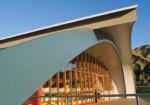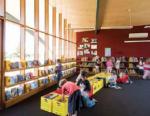Combining Form & Function
by Graham Hepburn
Architectural designer Chris Shaw gets a kick out of combining form and function in his projects and that’s highly evident in the Wainui Beach School library.
The wave-shaped roof of the building references Wainui Beach’s surf culture and its reputation as having one of the best surf breaks in the country. But the design also provides a “shop front” for the library to entice children into reading and creates a sheltered deck for school events such as speeches or musical performances. Children are encouraged to take books outside to read, and the full-width steps can also be used as seating for spectators at school sports days. Chris, who is a school parent and sits on Wainui Beach School’s board of trustees, says the need for a new library arose when the original library, which occupied an old classroom, was “commandeered” so the school could meet the new national staffing requirements of one teacher to 15 pupils.
The school, just north of Gisborne, has a roll of around 220 pupils and because of its size was allowed a library with a maximum floor area of 78sq m under Ministry of Education guidelines.
Chris says the wave shape for the library emerged from his first sketches and was a natural fit for the school.
“Wainui beach is a community based around its renowned surf beach and the surf culture that informs day to day life,” he says. “The beach is used as an outdoor classroom and the students are involved with surfing through the school surf club. The waves are the community playground and so the wave shape is used to represent that.”
It also meant that he could give what was essentially a small building some volume by casting a large, curved roof over it that also provided covered outdoor areas. Using COLORSTEEL® Maxx® for the roof was a logical choice as it could withstand the coastal environment and easily be rolled to the curve of the roofline.
“Just the lines of the corrugations look good; it’s another nod to the wave,” says Chris, who says the roof was deliberately made a light colour to reflect as much heat as possible. Having the roof curve up from the ground on the western side also means it turns its back on the sun during summer, preventing
overheating.
Underneath the roof are two layers of R2.2 Batts laid at right angles to each other.
Another feature of the roof that combines form and function is the lack of guttering on the eastern end. Water from the roof falls into the garden, providing vital watering for the plants in a community that has little water to spare for irrigation as it relies on collecting its own rainwater. “You also get rain
cascading off the roof and that’s a reference to the spray that comes off a wave,” says Chris.
The main structure of the building is three curved glue laminated beams anchored to substantial concrete piles on the eastern side to prevent uplift if wind gets under the large roof overhang. With the curved roof beams in place the structure was simply close-spaced purlins forming roof and walls.
To create the “shop front”, the northern and southern end walls of the library are glass with tall macrocarpa mullions forming part of the shelving system for the books. “The shelving for the books also performs as part of the structure, providing lateral stiffening for the mullions,” says Chris. “I like it when you can get a feature to do two jobs like that.”
Books on these shelves face out to catch the attention of passing children, and the books are rotated so that they relate to whatever topics classes are studying.
‘So many libraries are a tomb for books and librarians are wary about having sun on books,” says Chris. “In summer that’s not an issue although it is designed to get winter sun coming in but the windows are double glazed with a UV filter.
“The whole idea is it’s a shopfront for the library because the role of the library is to sell the love of reading and literature to kids.”
Shelving is arranged around the perimeter of the library to create an open plan space in the middle that can be used for readings or drama. Inside, there is a librarian’s office, open to view, an issues desk and a tiered seating nook where teachers can to read to students. Overhead, the curved poplar plywood ceiling is a feat of craftsmanship. “This was a difficult job at the junction of the ceiling and angled exterior glass wall where the plywood sheets needed to be curved with an angled cut that was notched to each timber mullion,” says Chris. “Cover beads or filler were forbidden and, to the builders credit, all joins and notches were perfect.”
Because the northern glass face of the library is angled in instead of being square, this creates a larger covered area on the north-eastern end of the building, something that was perfect for the band that played at a recent community hangi at the school when it turned a bit rainy.
For his library design, Chris won two categories in the Architectural Designers New Zealand Regional Design Awards last year - Commercial Interior Design and
Colour in Design. The judges said: “The resulting school library is appealing, functional, vibrant and ideally suited to the Gisborne environment with a
wave-shaped roof line reflecting the region’s strong coastal influences. A covered veranda frontage provides a generous outdoor performance space for school and community activities.”
But the greatest plaudits come from the schoolchildren who are “bursting at the seams” to use the library since it opened a year ago, says Chris.
“I was speaking to the principal and she was saying that it’s a treat for the kids to go to the library now.”
Pacific Modern Architecture
A small, design-led practice based at Wainui Beach, Pacific Modern Architecture draws its inspiration from the dynamic coastal landscape. The firm is developing a modernist response to our South Pacific lifestyle with sustainability a prime consideration. Designs employ natural ventilation and shade for
the hot summer months while key elements for winter are deep sun penetration, thermal mass and solid insulation to create stable and comfortable buildings that sit elegantly and naturally within the environment.





